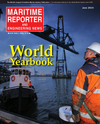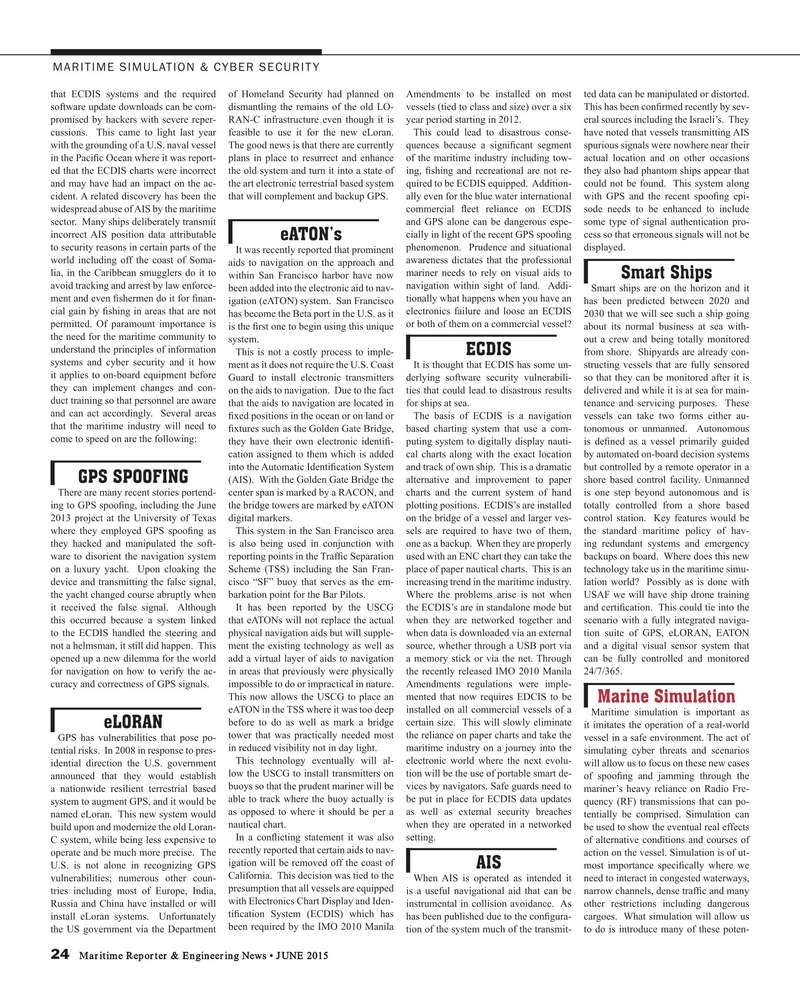
Page 24: of Maritime Reporter Magazine (June 2015)
Annual World Yearbook
Read this page in Pdf, Flash or Html5 edition of June 2015 Maritime Reporter Magazine
MARITIME SIMULATION & CYBER SECURITY that ECDIS systems and the required of Homeland Security had planned on Amendments to be installed on most ted data can be manipulated or distorted. software update downloads can be com- dismantling the remains of the old LO- vessels (tied to class and size) over a six This has been con? rmed recently by sev- promised by hackers with severe reper- RAN-C infrastructure even though it is year period starting in 2012. eral sources including the Israeli’s. They cussions. This came to light last year feasible to use it for the new eLoran. This could lead to disastrous conse- have noted that vessels transmitting AIS with the grounding of a U.S. naval vessel The good news is that there are currently quences because a signi? cant segment spurious signals were nowhere near their in the Paci? c Ocean where it was report- plans in place to resurrect and enhance of the maritime industry including tow- actual location and on other occasions ed that the ECDIS charts were incorrect the old system and turn it into a state of ing, ? shing and recreational are not re- they also had phantom ships appear that and may have had an impact on the ac- the art electronic terrestrial based system quired to be ECDIS equipped. Addition- could not be found. This system along cident. A related discovery has been the that will complement and backup GPS. ally even for the blue water international with GPS and the recent spoo? ng epi- widespread abuse of AIS by the maritime commercial ? eet reliance on ECDIS sode needs to be enhanced to include sector. Many ships deliberately transmit and GPS alone can be dangerous espe- some type of signal authentication pro- incorrect AIS position data attributable cially in light of the recent GPS spoo? ng cess so that erroneous signals will not be eATON’s to security reasons in certain parts of the It was recently reported that prominent phenomenon. Prudence and situational displayed.
world including off the coast of Soma- aids to navigation on the approach and awareness dictates that the professional lia, in the Caribbean smugglers do it to within San Francisco harbor have now mariner needs to rely on visual aids to
Smart Ships avoid tracking and arrest by law enforce- navigation within sight of land. Addi- been added into the electronic aid to nav- Smart ships are on the horizon and it ment and even ? shermen do it for ? nan- igation (eATON) system. San Francisco tionally what happens when you have an has been predicted between 2020 and cial gain by ? shing in areas that are not has become the Beta port in the U.S. as it electronics failure and loose an ECDIS 2030 that we will see such a ship going permitted. Of paramount importance is is the ? rst one to begin using this unique or both of them on a commercial vessel?
about its normal business at sea with- the need for the maritime community to system. out a crew and being totally monitored understand the principles of information
This is not a costly process to imple- from shore. Shipyards are already con-ECDIS systems and cyber security and it how ment as it does not require the U.S. Coast It is thought that ECDIS has some un- structing vessels that are fully sensored it applies to on-board equipment before Guard to install electronic transmitters derlying software security vulnerabili- so that they can be monitored after it is they can implement changes and con- on the aids to navigation. Due to the fact ties that could lead to disastrous results delivered and while it is at sea for main- duct training so that personnel are aware that the aids to navigation are located in for ships at sea. tenance and servicing purposes. These and can act accordingly. Several areas ? xed positions in the ocean or on land or The basis of ECDIS is a navigation vessels can take two forms either au- that the maritime industry will need to ? xtures such as the Golden Gate Bridge, based charting system that use a com- tonomous or unmanned. Autonomous come to speed on are the following: they have their own electronic identi? - puting system to digitally display nauti- is de? ned as a vessel primarily guided cation assigned to them which is added cal charts along with the exact location by automated on-board decision systems into the Automatic Identi? cation System and track of own ship. This is a dramatic but controlled by a remote operator in a
GPS SPOOFING (AIS). With the Golden Gate Bridge the alternative and improvement to paper shore based control facility. Unmanned
There are many recent stories portend- center span is marked by a RACON, and charts and the current system of hand is one step beyond autonomous and is ing to GPS spoo? ng, including the June the bridge towers are marked by eATON plotting positions. ECDIS’s are installed totally controlled from a shore based 2013 project at the University of Texas digital markers. on the bridge of a vessel and larger ves- control station. Key features would be where they employed GPS spoo? ng as This system in the San Francisco area sels are required to have two of them, the standard maritime policy of hav- they hacked and manipulated the soft- is also being used in conjunction with one as a backup. When they are properly ing redundant systems and emergency ware to disorient the navigation system reporting points in the Traf? c Separation used with an ENC chart they can take the backups on board. Where does this new on a luxury yacht. Upon cloaking the Scheme (TSS) including the San Fran- place of paper nautical charts. This is an technology take us in the maritime simu- device and transmitting the false signal, cisco “SF” buoy that serves as the em- increasing trend in the maritime industry. lation world? Possibly as is done with the yacht changed course abruptly when barkation point for the Bar Pilots. Where the problems arise is not when USAF we will have ship drone training it received the false signal. Although It has been reported by the USCG the ECDIS’s are in standalone mode but and certi? cation. This could tie into the this occurred because a system linked that eATONs will not replace the actual when they are networked together and scenario with a fully integrated naviga- to the ECDIS handled the steering and physical navigation aids but will supple- when data is downloaded via an external tion suite of GPS, eLORAN, EATON not a helmsman, it still did happen. This ment the existing technology as well as source, whether through a USB port via and a digital visual sensor system that opened up a new dilemma for the world add a virtual layer of aids to navigation a memory stick or via the net. Through can be fully controlled and monitored for navigation on how to verify the ac- in areas that previously were physically the recently released IMO 2010 Manila 24/7/365.
curacy and correctness of GPS signals. impossible to do or impractical in nature. Amendments regulations were imple-
This now allows the USCG to place an mented that now requires EDCIS to be
Marine Simulation eATON in the TSS where it was too deep installed on all commercial vessels of a
Maritime simulation is important as before to do as well as mark a bridge certain size. This will slowly eliminate it imitates the operation of a real-world eLORAN
GPS has vulnerabilities that pose po- tower that was practically needed most the reliance on paper charts and take the vessel in a safe environment. The act of in reduced visibility not in day light.
tential risks. In 2008 in response to pres- maritime industry on a journey into the simulating cyber threats and scenarios
This technology eventually will al- electronic world where the next evolu- idential direction the U.S. government will allow us to focus on these new cases announced that they would establish low the USCG to install transmitters on tion will be the use of portable smart de- of spoo? ng and jamming through the a nationwide resilient terrestrial based buoys so that the prudent mariner will be vices by navigators. Safe guards need to mariner’s heavy reliance on Radio Fre- system to augment GPS, and it would be able to track where the buoy actually is be put in place for ECDIS data updates quency (RF) transmissions that can po- named eLoran. This new system would as opposed to where it should be per a as well as external security breaches tentially be comprised. Simulation can nautical chart.
build upon and modernize the old Loran- when they are operated in a networked be used to show the eventual real effects
In a con? icting statement it was also setting.
C system, while being less expensive to of alternative conditions and courses of operate and be much more precise. The recently reported that certain aids to nav- action on the vessel. Simulation is of ut-
U.S. is not alone in recognizing GPS igation will be removed off the coast of most importance speci? cally where we
AIS
California. This decision was tied to the vulnerabilities; numerous other coun- When AIS is operated as intended it need to interact in congested waterways, is a useful navigational aid that can be narrow channels, dense traf? c and many tries including most of Europe, India, presumption that all vessels are equipped instrumental in collision avoidance. As other restrictions including dangerous Russia and China have installed or will with Electronics Chart Display and Iden- install eLoran systems. Unfortunately ti? cation System (ECDIS) which has has been published due to the con? gura- cargoes. What simulation will allow us the US government via the Department been required by the IMO 2010 Manila tion of the system much of the transmit- to do is introduce many of these poten- 24 Maritime Reporter & Engineering News • JUNE 2015
MR #6 (18-25).indd 24 MR #6 (18-25).indd 24 6/9/2015 10:02:48 AM6/9/2015 10:02:48 AM

 23
23

 25
25
